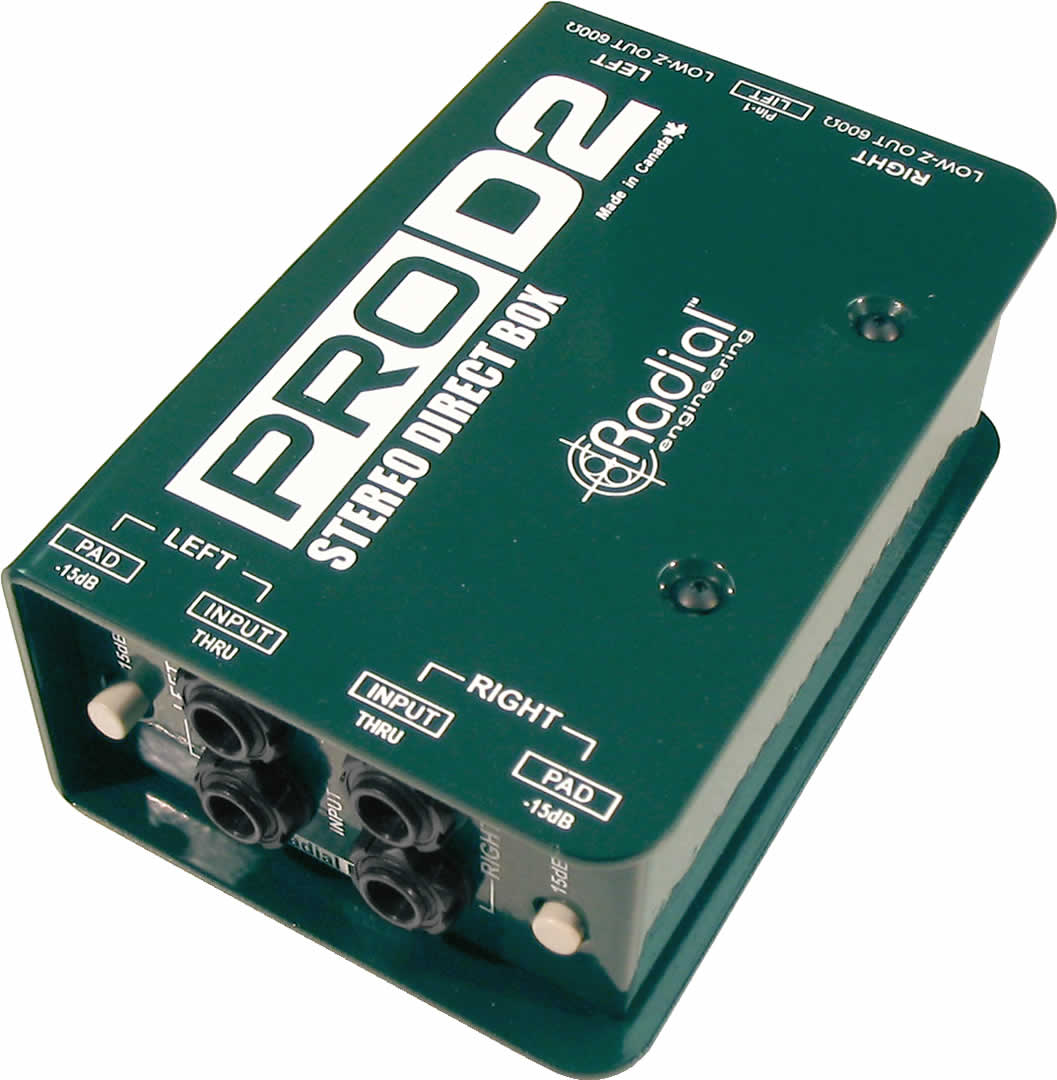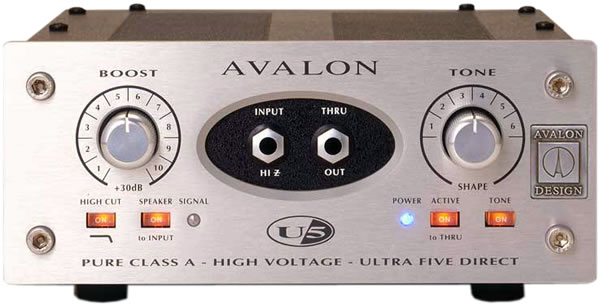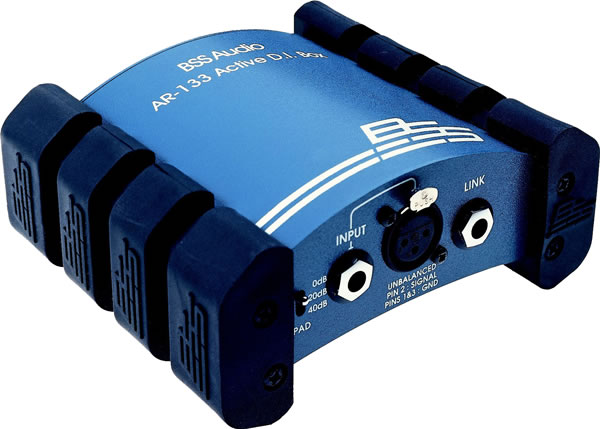Radial Engineering J48
Boite de direct active




















Descriptions détaillées
Start Module Points
- Ultra low distortion of all types
- Exceptional headroom & dynamic range
- Retains instrument's natural sound
- Powered by 48V phantom
End Module Points Intro Content
The Radial J48 has been designed from the ground up to deliver the most natural tone. As a direct box manufacturer, we do not believe it is our task to alter the sound of your prized '1962 Fender Jazz Bass', but retain and transfer the true character of the instrument to the mixing console without adding distortion or introducing artifact. This design philosophy has gained a tremendous following from many of the world's most demanding musicians.
Using only 48V phantom power, the Radial J48 is an active direct box that produces an exceptionally linear response that extends from 20Hz up to well above 40kHz. Low distortion of all types is achieved via a unique digital switching power supply that raises the internal operating rail voltage for added headroom and improved signal handling. The results are truly amazing. The J48 delivers an ideal even-order harmonic cascade and a sonic performance that outperforms DIs costing several hundreds more.
And like all Radial products, the J48 is both feature-rich for studio and made tough to handle the road. This includes a -15dB input pad to tame extra loud signals, 180º polarity reverse for feedback control on stage and a ground lift to help reduce hum & buzz caused by ground loops. Special features include a merge function that elegantly mixes left-right signals to mono without phase cancellation. To minimize resonant feedback with acoustic instruments, the J48 is also equipped with an 80Hz high-pass filter (low-cut). When engaged, this also increases headroom by eliminating unneeded bass frequencies.
Radial's innovative book-end design protects switches and connectors from abuse while the internal I-beam construction eliminates stress on the PC board. This serves to reduce solder joints from going 'cold' and delivers trouble-free performance for years. A full-bottom no-slip pad provides mechanical and electrical isolation while providing plenty of 'stay-put' for rockin' stages!
The Radial J48 is used by artists as diverse as acoustic guitarist Tommy Emmanuel; super-star engineer Joe Chiccarelli; and one of the most successful bands of all time Fleetwood Mac. The Radial J48… the world's finest 48V phantom powered active direct box.
J48 for Live Touring
A direct box is primarily used to get an instrument signal from the stage to the mixing desk and PA system. The Radial J48 delivers the natural tone exceptionally long distances without adding distortion or coloring the sound in any way.
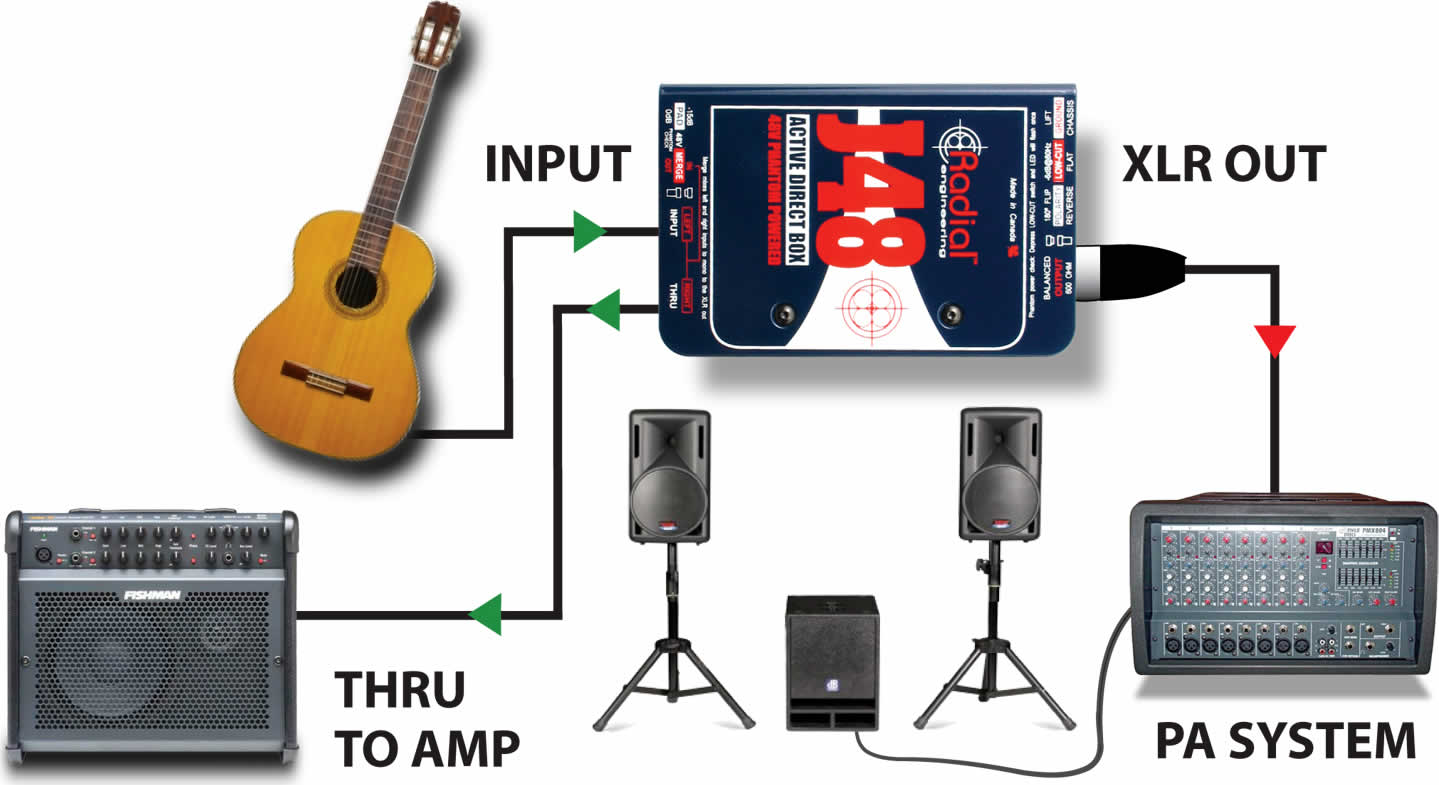
J48 in the Studio
When recording direct, the quality of the direct box interface assures the purest signal going to the track. The Radial J48 is particularly well suited for recording bass or capturing a direct track from a guitar.
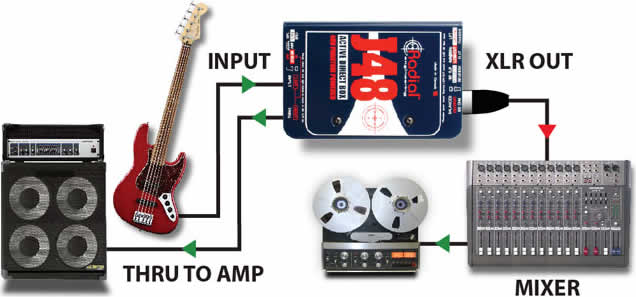
Reamping™ with the J48
Reamping means sending a dry track from the recorder back out to pedals and amps. This tricks has been used for years by top professionals. The Radial J48 is ideally suited to capture the sound of the instrument for later Reamping.
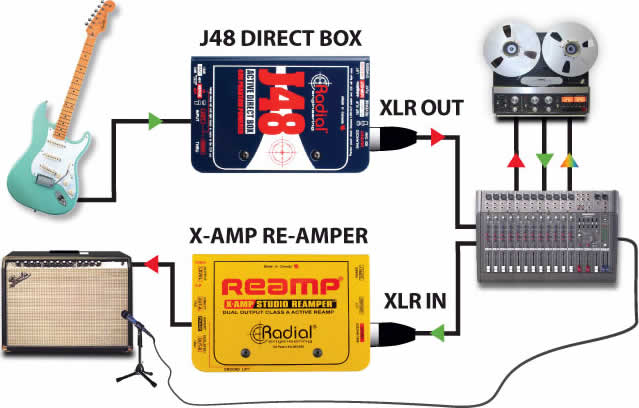
J48™ Development
Comparing an active direct box to a passive DI is akin to comparing a condenser microphone to a dynamic. Both have benefits and advantages. But what few realize is that an active direct box is in fact a pre-amplifier. And as anyone in audio knows, you can find mic-preamps for $99 or spend as much as $5000, depending on the brand, hype, features and quality expectations you may have.
When the first direct boxes appeared, they were simple transformer based devices. The passive DI boxes took the signal from the instrument and split it between the musician's stage amplifier and the PA system, both changing the impedance and balancing the signal at the same time. A problem with passive DI boxes became apparent when musicians using low output instruments realized that the sound from their bass would be thinner than when connected directly. This effect became known as 'loading'.
This created a need for the direct box to buffer the signal or amplify it so that the draw going to the PA would not affect the signal going to the amplifier. This worked well except that in order to power the active direct boxes circuit, one had to either provide local AC or use a battery. Finding AC may sound simple but more often than not. AC is rarely where you really want it on stage and this means bringing out extension cords. Batteries do not fair much better. When fully charged, batteries work fine, but as the charge diminishes, distortion increases and invariably, batteries fail in the most inopportune times. (Like in the middle of a song!). This same problem was occurring with microphones. Folks wanted condenser mics on stage, but due to powering restrictions, their use was limited.
Enter the Phantom
In the 1960s, condenser microphone pioneer Georg Neumann invented phantom power. His concept was simple: if he could find a way to remotely power his microphones, they could be used along side dynamic mics on stages around the world. Phantom power presents a relatively high voltage to the microphone's internal amplifier that polarizes the capacitive plates (diaphragms). Following the same idea as high-tension power lines, a high voltage was employed with a very low current. This concept worked extremely well allowing the power totraveldistances - over a thousand feet (300 meters) and suppl the microphones internal electronics.
Some 20 years later, as low cost, high efficiency integrated circuits became available, the first phantom powered direct boxes appeared. These worked extremely well! Back then, virtually all bass guitars were passive instruments made by Fender such as the Precision or the Jazz bass, the common stage piano was the Fender Rhodes and acoustic guitars were outfitted with low output Barcus Berry pickup systems or magnetic offerings from Bill Lawrence. The reason these old DI boxes worked well was that these instruments had one thing in common: They all had a low output.
The World Changed
Today, acoustic guitars are equipped with built-in active preamps with tons of output level. The majority of all bass guitars have one and sometimes two batteries in them and tons of on-board active electronics. Pianos and synthesizers have gone digital with more dynamic range than ever before and electronic drums and digital sampling is now standard on most stages.
The problem is that these high output instruments have so much level; they overload the direct boxes of yesteryears. Now you may ask: why not simply increase the level handling of the direct box? And rightfully so: we asked ourselves the same question. The answer is that when Mr. Neumann invented phantom power, he never once considered that his powering scheme would be used to supply an instrument preamplifier (ie: a direct box) and therefore, never provided sufficient current to do the job. Without current, there is no power without power, you have no headroom. Without headroom, the moment you drive a loud signal into the circuit, it overloads. It chokes. When you exceed the operating voltage, the signal gets clipped. In essence, it immediately transitions from say 0.05% distortion to 100% distortion. And worst of all, these chips and circuit designs which were optimized to work under limited current, produce odd-order harmonic distortion, which causes a harsh, undesirable tone.
A Digital Revolution
This of course led us to look for a solution. We needed more power to drive the circuit in effort to increase the rail voltage. Batteries were out of the question. Local powering was also out. We noticed a new technology being used in power amplifiers known as class-D or digital switching. These new high efficiency amplifiers are able to produce thousands of watts of power while drawing very little current. This pointed us to creating a similar solution inside the Radial J48.
What we are in fact doing is taking 48 volt DC phantom power, converting it to AC, then running it through a proprietary power transformer using a high-speed digital switching circuit. This provides us with almost three times more voltage found in other direct boxes and enables us to create a circuit that is not based on compromising tone for efficiency; it is based on reducing distortion and delivering pristine signal transfer.
This innovative circuit also uncovered another valuable advantage quite by accident: the transformer served to isolate the power which in turn, reduced hum & buzz caused by ground loops. Keep in mind that if a transformer is used on the XLR at the output, 48 volt phantom power cannot be used as the DC current will be blocked by the transformer. If transformer isolation is used on the input, the same loading effect as described earlier reappears and we may as well use a passive DI box as we have not solved the primary goal. By transformer isolating the signal 'inside the circuit', we achieve a wonderful balance of both performance and reduced noise.
We then took the Radial J48 a step further by adding a number of useful features: To begin, the input impedance at 220kohms is high, but not so high as to cause the instrument to sound glassy. Through experimentation and lots of listening, higher 1 MegOhm inputs offered by others work reasonably well with piezo pickups, but they tend to sound edgy with most basses and guitars.
We then added a smooth 80 Hz low-cut (high-pass filter) that would both increase headroom by reducing power-hungry bass while eliminating low-frequency resonance, the prime cause of acoustic feedback on stage. We incorporated features such as a ground lift (not at the XLR out but inside the circuit), 180º polarity reverse to help align the PA and reduce run-away resonance when stage monitors conflict with onstage amplification.
Finally, we packaged the J48 in a protective book-end design to provide the switches and jacks with a protective zone. Internally, a unique I-beam construction provides a rigid monocoque platform that eliminates any opportunity for the PC board to torque, further reducing field service problems. A full bottom isolation pad provides both mechanical and electrical isolation against the constant abuse on stage while reducing the opportunity for steel-on-steel contact with electronic devices such as bass ans guitar ampswhich of course could introduce system noise or electrical shock.
Great features, low distortion and natural sound combine to make the Radial J48 one of the most popular professional direct boxes used today.
J48™ Using & Applications
The Radial J48 is a pleasure to use. It is 'plug & play' easy and is perfectly adept for studio as well as live concert sound. The following describes the basic approach to using the J48. For full details, please view the full J48 user's guide.
Overview
The Radial J48 is a professional direct box that is equally useful for studio as it is for performance. It serves the purpose by converting the high impedance output of an instrument to a low input impedance, microphone level signal that is compatible with mixing console inputs. It also balances the signal to allow long runs to upwards of 1000 feet (300 meters) without appreciable signal loss or noise.
Unlike typical direct boxes that simply use phantom power to drive an internal buffer, the J48 actually converts phantom power from DC to AC, then uses a unique internal switching power supply to increase the internal working voltage in order to achieve much greater headroom. Because of this process, the active amplifier (buffer) is not constantly red lining. This means we do not have to trade off frequency response for dynamic range. The result is a response curve that starts at 10Hz and extends well above 40kHz! This assures the natural tone of the instrument is retained without degradation or introducing artifact.
Making Connections
As with any electronic audio device, make sure all levels are turned down and/or power is off before making connections. This avoids power-on transients or capacitor discharge from harming speaker components.
Standard Instrument Setup
- Connect a ¼" cable from your instrument to the J48 input.
- Connect a ¼" cable from the thru connector to your instrument amplifier. This 'straight through' parallel connection is easily tested by turning up your amp. Always test at a low volume to make sure connections and cables are working properly.
- Connect an XLR cable from the J48 output to a mic-preamp input on your mixing console. Make sure you turn the 48V phantom power on. Today pretty much all mixers are equipped with 48V phantom powering. This ingenious system sends a DC signal back to the J48 that powers the internal amplifier and does not interfere with the AC audio signal path.
- Slowly turn the volume up on your mixer to a low level and test to make sure signal is present. If you encounter any buzz or hum, try lifting the ground. Begin playing. If you encounter any distortion, lower the source volume or hit the input pad.
- It's that easy! You are set to go!
Once connected, turn on your sound system. Make sure the 48V phantom power on the console is on before you turn up the system volume levels. To check for phantom power, depress the 80Hz high-pass filter on the J48 while looking at the LED. It should flash once to tell you that phantom power is present. The LED will not stay on. This is done on purpose to deploy all available current from phantom to the audio circuit. You are now ready for audio testing. Play your bass or acoustic guitar. You should be able to hear it in you stage amp if one is connected. Slowly increase the sound level. If you encounter any hum or buzz, try lifting the ground on the J48. This can often be used to eliminate the hum caused by ground loops.
Specifications
- Audio circuit type : Proprietary analog circuit with low-noise op-amp
- Frequency response : 20Hz ~ 20kHz
- Dynamic range : 109dB
- Noise floor : -99dB below 0dBu
- Equivalent input noise : -103dBu
- Maximum input : +10dBu
- Phase deviation : +10º at 20Hz | 0º at 1kHz | -1º at 20kHz
- Total harmonic distortion : 0.002% @ -5dBu
- Inter-modulation distortion : 0.003% @ -3dBu
- Input impedance : 220kΩ - ¼" input
- Output impedance : 600Ω - XLR output
Features
- Merge function : IN and THRU jacks are summed to mono
- Input pad : -15dB
- Polarity : 180º signal polarity reverse switch
- Low-cut filter : -3 dB @ 80Hz
- Ground lift : Disconnects pin-1 at XLR output
- XLR configuration : AES standard (pin-2 hot)
General
- Power : 48V phantom - proprietary digital switching
- Construction : 14 gauge steel chassis and outer shell
- Finish : Durable powder coat
- FCC approval : Complies with section 15 of the FCC Rules
- Conditions : For use in dry locations only between 5°C and 40°C

- Référence : J48
- Codart : DI-RADJ48
- Télécharger nos catalogues PDF
- Dimensions unitaires : 84 x 127 x 48 mm
- Poids unitaire : 720 g

